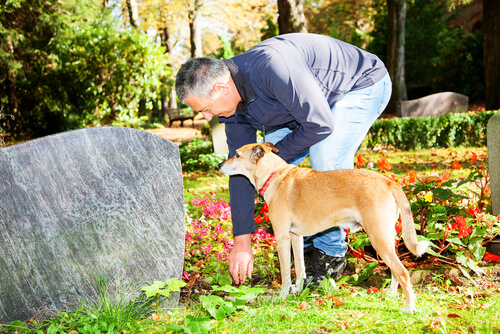Mourning a Pet: The Same as Mourning a Person?

When a dog or a cat dies, the majority of owners experience the same feelings as if they had lost a loved one. Mourning a pet in many cases is even greater than that reserved for a person. Find out more in this article.
Mourning a pet: a painful moment
People who have suffered the death of a dog or cat know pain. Most pet owners experience sleeping disorders, problems eating or problems with daily life after the loss of their best friend.

In addition, many struggle to concentrate. They have lower energy, depression and apathy. Some couples that don’t have children consider their cat or dog as “their baby.” These pet owners have a higher chance of separation after the death of an animal.
While the opposite is believed to be true, cat owners feel greater pain when their pets pass away than dog owners. Why? Because cats are raised in smaller spaces. Also, they say, they have a spiritual connection with people.
The elderly and children more vulnerable to mourning a pet
The impact of the death of a dog or cat will depend on the personality of each person. However, this event impacts two groups of people most: the elderly and children.
In the first case, it’s likely that the animal has been this elderly person’s only company for a while. In the second case, many children have had a pet since birth. For them, it’s difficult to overcome that loss.
As it happens with the death of any loved one, it’s fundamental to go through the process of pain and grief over a pet. Meaning, completing the cycle from burying the pet to remembering him with affection.
Mourning a pet
One of the first reactions of a person when his or her dog or cat dies is not understanding the situation. Even if the animal has lived a long life or suffered from a chronic disease (that supposedly prepares us for the natural outcome), we still suffer when he’s no longer there at our side.
After the pet has been buried or cremated, it’s normal to feel her presence around us. Hearing her little paws at the side of the bed or his meows at the door is very normal. Some say that their souls still continue on to tell us that everything will be okay. Others claim that it’s a habit of the senses to those sounds.
In daily situations, where the animal often shared moments with us, it’s where we most feel the pain of their death. Getting home from work, no one is waiting for us with their tail wagging. Or we don’t feel that purring on the days of winter, or we miss playing with someone in the park, etc.
The elderly and children are more vulnerable to suffering from the death of a pet.
With the passing of time, the memories of that wonderful being don’t hurt so much nor make us cry. It’s easier to see a photograph of our pet. Or to speak fondly of their adventures without feeling so sad.

Burial and sharing memories
If our pet is buried in an animal cemetery, we can go to visit their grave. We can bring them toys. Otherwise, we could post photos on a virtual cemetery. (There are many on the internet.) And, we can leave a message there. These sites show that we’re not the only ones going through grief.
It’s recommended to bring another dog or cat home only once we have processed the loss. Many people go running to buy or adopt another pet. They believe that it’s the best way to move on. Nevertheless, this may be counterproductive. Why? Because we won’t be in a condition to take care of that new life. Also, we will compare him continually to the animal who has passed away.